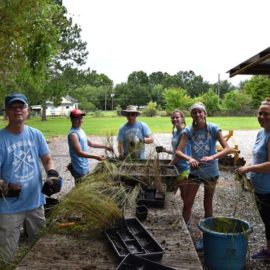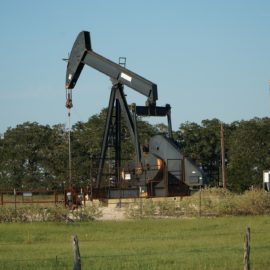
PHOTO FROM LOUISIANA DEPARTMENT OF NATURAL RESOURCES
We have a lot of unplugged oil wells and closing them in wildlife havens is a good start.
Many of Louisiana’s most prized and protected natural landscapes are dotted with the leaking, rusty remnants of the oil industry’s boom years. A federally-funded program is beginning work this week to plug about 150 of these ‘orphan’ oil and gas wells in five national wildlife refuges in Louisiana. The work is funded with $12.7 million from last year’s Infrastructure Investment and Jobs Act, a massive bipartisan law that’s putting $1.2 trillion into roads, bridges, ports and other infrastructure. Orphan wells often leak oil and emit methane, a pollutant that harms air quality and contributes to climate change. The wells’ impact can be slow, with small amounts of oil seeping into waterways and marshes over many years, or they can be sudden and potentially devastating if struck by a hurricane.
nola.com
I am concerned that the state does not mandate that the oil companies drill must plug when they leave.
Louisiana has documented more than 4,600 such wells, and the number is expected to rise as small and mid-sized companies shut down and the industry continues to shift its focus to larger, cheaper sources of fossil fuel outside the state. Sites are classified as “orphaned” when wells are no longer used and their operators have gone bankrupt, can’t be located, or are unable or unwilling to maintain their sites. The infrastructure bill will put more than $1 billion toward plugging and remediating orphan wells across the country. National wildlife refuges are an initial focus of the federal spending. The five Louisiana refuges targeted for well plugging get heavy use from hunters and anglers. “Louisiana has such a large sportsman community,” Jim Guthrie, a U.S. Fish and Wildlife Service policy advisor, said by phone during a visit to refuges in north Louisiana on Thursday. No one wants to see “sheeny patches from oil, or grasses that are just dead” while they’re hunting ducks or catching fish, he said.

U.S. Fish and Wildlife Service
The projects in Louisiana include:
68 wells in the D’Arbonne National Wildlife Refuge near Monroe. 59 wells in Upper Ouachita National Wildlife Refuge along the Arkansas line near Marion. 11 wells in Lacassine National Wildlife Refuge southeast of Lake Charles. 7 wells in the Atchafalaya National Wildlife Refuge between Baton Rouge and Lafayette. 6 wells in the Black Bayou Lake National Wildlife Refuge north of Monroe. Plugging old wells in wild spaces isn’t easy. Only 18 wells will be plugged in the state’s coastal zone. South Louisiana has hundreds of orphaned wells that are at increasing risk from waves and storms as the coast sinks and erodes, but plugging them is far more complicated and costly, and the accidental release of oil could cause substantial environmental harm if it occurs in or near water.

U.S. Fish and Wildlife Service
This is being funded by the Infrastructure Law that only 2 of the 7 congressional delegates supported.
Proposed by President Joe Biden’s administration and approved by Congress in November, the infrastructure law puts more than $1 billion toward well plugging and remediating wells across the country. Taxpayers are footing the bill for problems caused by companies that have managed to escape responsibility by disappearing, at least in a legal sense. “In a lot of cases, the owner of record doesn’t exist anymore,” Guthrie said. Of the $1 billion for well-plugging, the Louisiana Department of Natural Resources has received $25 million to tackle a few hundred wells in the Monroe and Shreveport areas. DNR will also administer the additional $12.7 million for wells in national wildlife refuges. DNR opted to focus on north Louisiana because the region has a dense concentration of relatively easy-to-access wells that are some of the oldest in the state, with many dating back to the early 1900s. The Shreveport and Monroe areas have almost 70% of the state’s orphan wells. “The well population is so intense there,” said DNR spokesman Patrick Courreges. “By focusing there, we get more bang for the buck.”

LOUISIANA DEPARTMENT OF NATURAL RESOURCES PHOTO
The contractors have been chosen.
The agency recently selected Dynamic Group of Houston and Lemoine Disaster Recovery of Lafayette to carry out the work. DNR also receives about $10 million per year in fees from the oil and gas industry to plug orphan wells. The fees allow DNR to plug between 120 and 200 wells per year. The federal boost in well-plugging will help but it won’t come close to erasing the problem, said DNR Secretary Tom Harris. “That does not solve all of our orphaned well issues, but it gives us some real momentum in our efforts to get that orphaned well population reduced,” he said. Plugging all of Louisiana’s orphan wells could employ just over 1,000 oil workers full-time for one year and cut methane emissions by 558 metric tons per year, according to a 2020 report by Columbia University and Resources for the Future, an environmental policy think tank. The methane reduction would be the equivalent of cutting annual greenhouse gas emissions from about 3,000 cars. The report estimates it would cost up to $2.7 billion to plug the nation’s documented inventory of nearly 60,000 orphaned wells. But the actual number of orphaned wells is potentially as high as 3 million. “The U.S. has been drilling for oil since the 1850s, and we haven’t been keeping track of (the wells) until modern times,” said Daniel Raimi, a public policy researcher and co-author of the report. “We simply don’t know where a lot of them are.”
A good start.



